 |
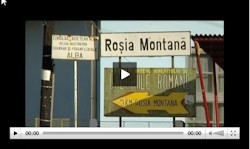 |
| Segment 1: Gabriel Resources, a Canadian based multinational, plans to build the largest gold mine in Europe. Its subsidiary — Rosia Montana Gold Corporation — was granted a 20-year exploration license, but first it would have to buy up hundreds of houses and displace almost an entire village. |
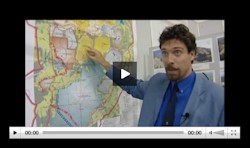 |
| Segment 2: John Aston, vice president of the Rosia Montana Gold Corporation, describes the company’s plans in a positive light. Remus Celusa, a resident of Rosia Montana, wonders why the corporation can’t mine the gold “without destroying our mountain and everything we own.” |
 |
| Segment 3: Gold Corporation began buying out homeowners in 2002, offering either cash or a home in a new community. While many people are taking advantage of the buyouts, others, like farmer Eugen David, are resisting. |
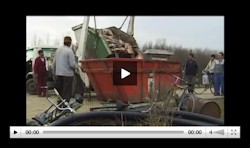 |
| Segment 4: The Rosia Montana gold mine has the potential for causing catastrophic environmental harm. In January 2000, heavy rains and snowfall flooded a holding pond of mining waste in the Romanian city of Baia Mare, spilling more than 20 million gallons of cyanide-laced sludge into the River Tisza. |
 |
| Segment 5: Gabriella Szekely, was a teacher in Rosia Montana for 34 years, but now has broken her ties with the village, and taken Gold Corporation’s money to leave. Margit Buran, a retired accountant is resolute – she won’t deal with the Canadian company. |
PBS
airs documentary on Cyanide Mine in Transylvania... Rumania plans
the destruction of churches, cemeteries, homes and displacing an entire
village to make room for one-mile-wide, open-pit cyanide mine, the largest gold mine in Europe.
Rumania annexed Transylvania and the Banat from Hungary after World War I at the Treaty of Trianon where Hungary lost an unprecedented 2/3 of her territory, 1/3 of her ethnic Hungarian population, and over 90% of her national railroads and natural resources. Transylvania, and expecially towns and villages inhabited by ethnic Hungaria communities, has long been a target for exploitation by the Rumanian government. Ceaucescu wanted to raze entire Hungarian vilages and replace them with communist-style, highly polluting industrial plants.
Today, over two decades after the Rumanian revolution that ended the brutal Ceaucescu dictatorship, another historic Translyvanian village with a significant ethnic Hungarian community, Rosia Montana (Verespatak in Hungarian), a gold producing area for over a millenia, is the site of another battle as the Rumanian government and international business join forces to divide an impoverished community in order to displace residents, flood huge areas, and establish an open-pit cyanide mine to extract what's left of the gold.
In 2000, the world watched in horror as a dam containing toxic waste material from the Baia Mare Aurul gold mine (Nagybánya in Hungarian) in North Western Romania burst and released 100,000 cubic meters of waste water, heavily contaminated with cyanide, into the Lapus and Somes tributaries of the river Tisza, one of the biggest in Hungary. Protestors warn of another cyanide-induced Rumanian environmental disaster.
PBS Television presented a documentary
film on the planned open pit cyanide gold mine at Verespatak in Transylvania,
now called Rosia Montana after Rumanian annexation. In "Gold Futures,"
WIDE ANGLE profiles rural farmers and townspeople confronting a choice,
as a Canadian company prepares to excavate a massive open-pit gold mine
where their village still stands. Hungarian film-maker Tibor Kocsis is
cinematographer, director and editor of Gold Futures, and has been following
the story of Rosia Montana for more than five years.
"Gold Futures" is a David-and-Goliath story set in a scenic
Romanian village in the heart of Transylvania. At stake: Europes largest
deposit of gold ore - and a 2000-year-old village community. Now, as a
Canadian company (RMGC) plans to excavate the largest open-pit gold mine
in Europe, mineral wealth and badly-needed jobs compete with time- honored
rural traditions and concerns about poisoning the environment.
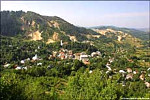 RMGC's
planned use of cyanide raises flags for some wary villagers who fear an
environmental disaster like the one that occurred in 2000, when a ruptured
dam at a nearby mine unleashed toxic cyanide sludge into the river system,
contaminating the drinking water of millions of people and killing more
than 1200 tons of fish downriver in Hungary. RMGC's
planned use of cyanide raises flags for some wary villagers who fear an
environmental disaster like the one that occurred in 2000, when a ruptured
dam at a nearby mine unleashed toxic cyanide sludge into the river system,
contaminating the drinking water of millions of people and killing more
than 1200 tons of fish downriver in Hungary.
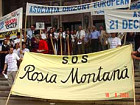 In addition to the threat of pollution, the project will mean the displacement
of the entire village and all its residents. Excavation of the new one-mile-wide
mine can't begin until hundreds of houses and nearby shops, churches and
even graveyards are demolished. Hungarians and Rumanians lived peacfully side-by-side for centuries. Together, joined by the world community, are working together to fight against the mine. [download
the Press Release] In addition to the threat of pollution, the project will mean the displacement
of the entire village and all its residents. Excavation of the new one-mile-wide
mine can't begin until hundreds of houses and nearby shops, churches and
even graveyards are demolished. Hungarians and Rumanians lived peacfully side-by-side for centuries. Together, joined by the world community, are working together to fight against the mine. [download
the Press Release]
[< Back to News from Rumania]
[< Go to all AHF news] |
Shortcuts
Related
Links
- No
Dirty Gold
- Salvati Rosia
Montana- "People are more important than gold. Save Rosia Montana."
In English, Hungarian, Romanian, and German
- RosiaMontana.org is a page maintained by volunteers supporting the activities of Alburnus
Maior, a Romanian NGO headquartered in Rosia Montana, Romania
- See Gabriel Mining's rebuttal: www.truestory.ru
- Case
Study on the Tisza cyanide disaster: The cyanide pollution of the
rivers Szamos and Tisza was caused by AURUL, an Australian-Romanian
joint venture that is situated in Romania’s Baia Mare (Nagybánya)
region, close to Rosia Montana
- Ramsar
Forum: Cyanide pollution of the rivers Szamos and Tisza
Why So Many Hungarians Across the Border?
 One thousand years of nation building successfully delineated groups based on culture, religion, geography, and other attributes to create the countries with which we are so familiar. While some Western European nations would continue power struggles and princely battles and civil wars, Hungary, founded in 896, was a peaceful multi-ethnic state for a 1000 years and her borders were virtually unchanged. Until 1920... One thousand years of nation building successfully delineated groups based on culture, religion, geography, and other attributes to create the countries with which we are so familiar. While some Western European nations would continue power struggles and princely battles and civil wars, Hungary, founded in 896, was a peaceful multi-ethnic state for a 1000 years and her borders were virtually unchanged. Until 1920...
The Treaty of Trianon in 1920... in the aftermath of WWI, was extremely harsh on Hungary and unjustifiably one-sided. The resulting "treaty" lost Hungary an unprecedented 2/3 of her territory, and 1/2 of her total population or 1/3 of her ethnic-Hungarian population. Add to this the loss of up to 90% of vast natural resources, industry, railways, and other infrastructure. The clear winner of the land grab, was Rumania, who, established only 60 years earlier, more than doubled in size overnight.
Ethnic Distribution in the Kingdom of Hungary in 1910 (Hungarians shown in red)
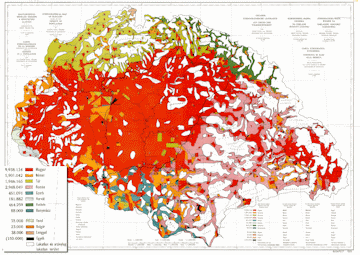
[download extra large image 4962x3509]
[download large image 1000x707]
Hungarian populations declined significantly after forced removals such as the Benes Decrees and other pograms, the effects of WWI, and Trianon in 1920. With continued pressure and discriminative policies such as the 2009 Slovak Language Law, this trend continued over the past 90 years.

- In Upper Hungary (awarded to Slovakia, Czechoslovakia): 1,687,977 Slovaks and 1,233,454 others (mostly Hungarians - 886,044, Germans, Ruthenians and Roma) [according to the 1921 census, however, there were 1,941,942 Slovaks and 1,058,928 others]
- In Carpathian Ruthenia (awarded to Czechoslovakia): 330,010 Ruthenians and 275,932 others (mostly Hungarians, Germans, Romanians, and Slovaks)
- In Transylvania (awarded to Romania): 2,831,222 Romanians (53.8%) and 2,431,273 others (mostly Hungarians - 1,662,948 (31.6%) and Germans - 563,087 (10.7%)). The 1919 and 1920 Transylvanian censuses indicate a greater percentage of Romanians (57.1%/57.3%) and a smaller Hungarian minority (26.5%/25.5%)
- In Vojvodina 510,754 Serbs and 1,002,229 others (mostly Hungarians 425,672 and Germans 324,017)
- In Vojvodina and Croatia-Slavonia combined (awarded to Yugoslavia): 2,756,000 Croats and Serbs and 1,366,000 others (mostly Hungarians and Germans)
- In Burgenland (awarded to Austria): 217,072 Germans and 69,858 others (mainly Croatian and Hungarian)
[read more on the Treaty of Trianon]
AHF Statements on Trianon:
AHF Articles on Rumania:
 You will need the free Adobe Reader to open the following files. Click the image to download. You will need the free Adobe Reader to open the following files. Click the image to download.
Articles and Essays by AHF Members
- "NATO Enlargement" by Frank Koszorus Jr. March 29, 2004
Remarks on the Occasion of the Enlargement of NATO, Corcoran Gallery of Art, Washington, D.C. [download]
---
- "Nato Enlargement And Minority Rights: Prerequisites To Security" by Frank Koszorus, Jr., April 2003
A memorandum that was submitted to Robert A. Bradtke, Deputy Assistant Secretary for European and Eurasian Affairs, and Heather A. Conley, Deputy Assistant Secretary for European and Eurasian Affairs during a roundtable discussion on "NATO Enlargement and the Current State of the Trans-Atlantic Alliance." This submission follows several other intiatives, including submissions to Lord Roberston, Secretary General of NATO. [download]
---
- “Nato Enlargement: Promoting Western Values, Strengthening The Alliance” by Frank Koszorus, Jr., April 29, 2003
A Statement Before The United States Senate Committee On Foreign Relations.
[download]
---
- "U.S. Senate Unanimously Ratifies Nato Treaty; Senators Raise Rights Of Minorities: Federation Supports Efforts Aimed At Encouraging Romania And Slovakia To Respect Rights Of Hungarian Minorities And Restore Communal Properties" - Press Release by Zoltan Bagdy, May 9, 2003 [download]
Congressional Resolutions and Records
- H.RES 191 - A RESOLUTION urging the "prompt and fair restitution of church properties by Romania and Slovakia - TOM LANTOS / TOM TANCREDO (April 6th 2005) in the House of Representatives [download]
- A RESOLUTION REGARDING THE ISSUE OF TRANSYLVANIAN HUNGARIANS -- HON. DONALD E. `BUZ' LUKENS (Extension of Remarks - February 26, 1990) in the House of Representatives [download]
- VIOLENCE IN TRANSYLVANIA -- HON. DON RITTER (Extension of Remarks - March 22, 1990) in the House of Representatives [download]
- Transylvanian Monitor #14: Property Restitution.
Join online!

|



